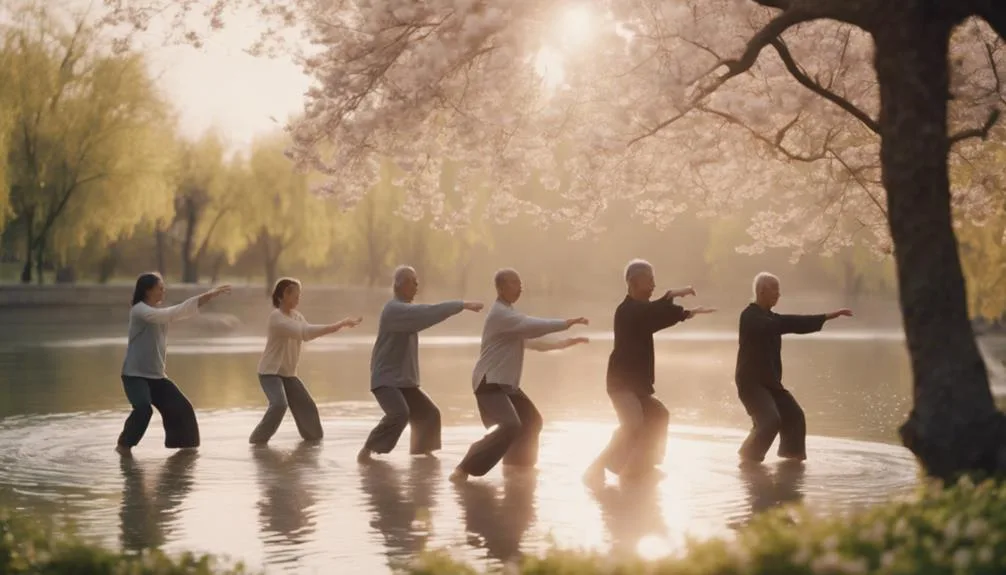Chinese Taoist Techniques for Achieving Mindfulness
Imagine the gentle flow of a mountain stream, its waters caressing ancient stones, a perfect metaphor for the Taoist approach to mindfulness.
You're about to embark on a journey where breath becomes your anchor, and your thoughts, like leaves on the water, drift away without attachment. Techniques such as Zhuanqi and Zuowang aren't just exercises; they're gateways to a profound inner peace and balance.
By understanding and practicing these methods, you'll not only enhance your emotional well-being but also connect with a centuries-old tradition that echoes the natural world's rhythms.
Curiosity piqued? Let's explore how these ancient practices can be integrated into your modern life, offering a sanctuary of calm in a chaotic world.
Key Takeaways
- Taoist meditation transforms internal energies for spiritual enlightenment and mindfulness.
- Tai Chi harmonizes meditation and movement, enhancing mental focus and inner peace.
- Qigong aligns breathing with movements, clearing the mind for heightened awareness.
- Incorporating Taoist rituals deepens the spiritual journey, crafting a mindful connection with the universe.
Understanding Taoist Philosophy
At its core, Taoist philosophy invites you to embrace a life of harmony, guided by the natural ebb and flow of existence, and to find balance in the Yin and Yang energies that permeate the world around us. This ancient wisdom encourages you to live in harmony with nature, recognizing that adapting to its ever-changing cycles isn't just about survival but about thriving in tranquility. As you align yourself with the natural flow, you'll discover a profound sense of inner peace, one that resonates deeply with the rhythms of the earth and the universe.
Taoism teaches that this balance isn't a static state but a dynamic harmony that requires constant adaptation and emotional regulation. By fostering a deep connection with the Tao, the underlying principle that governs all, you're invited to experience life in the present moment, fully and without reservation. This mindful approach doesn't just reduce stress levels; it enhances your energy flow and connects you to a broader, more serene outlook on life. In embracing Taoist philosophy, you're not just learning ancient concepts; you're embarking on a journey towards a more balanced, peaceful existence, deeply rooted in the wisdom of nature.
Taoist Meditation Practices
As you explore Taoist meditation practices, it's essential to understand the role of Inner Alchemy Basics and the Zazen Sitting Method. These techniques offer a path to transform your mental and emotional landscape, fostering a profound connection with your inner self.
Inner Alchemy Basics
Embarking on the journey of inner alchemy invites you to transform and refine your internal energies through ancient Taoist meditation practices. This path is both sacred and profound, guiding you to cultivate the Three Treasures—Jing, Qi, Shen—toward achieving balance and unity within. Through breath control, visualization, and energy cultivation, you delve deep into the essence of your being, harmonizing the Yin and Yang forces that animate your existence.
| Technique | Focus | Outcome |
|---|---|---|
| Breath Control | Jing to Qi | Energy Cultivation |
| Visualization | Qi to Shen | Spiritual Enlightenment |
| Energy Cultivation | Shen in Harmony | Yin and Yang Harmonization |
This table encapsulates the essence of inner alchemy, where discipline and dedication lead you to a state of mindfulness and spiritual awakening.
Zazen Sitting Method
Exploring the Zazen Sitting Method opens a gateway to mastering mindfulness through the disciplined stillness of Taoist meditation. You'll find yourself embracing a practice that not only enhances your presence but also deepens your connection with your breath and the subtle sensations of your body. This method is a cornerstone in the cultivation of inner peace and clarity.
- Sit with a straight back and relaxed shoulders
- Focus on breath and body sensations
- Embrace stillness to quiet the mind
- Maintain eyes partially open for alertness
- Practice consistently for emotional balance
The Zazen Sitting Method invites you into a world where mindfulness isn't just a concept, but a lived experience, offering a path to understanding that's both reflective and profound.
The Role of Tai Chi

Delving into Tai Chi, you'll discover a traditional Chinese martial art that not only fosters physical well-being but also deeply enriches mental focus and inner peace. This Taoist practice harmonizes meditation and movement, guiding you towards a state of mindfulness where each motion flows into the next with grace and purpose.
The slow, deliberate movements of Tai Chi promote relaxation and balance, offering stress relief that's so needed in today's fast-paced world.
As you engage with Tai Chi, you'll notice an improvement in your flexibility and coordination, enhancing your overall well-being. But beyond the physical, Tai Chi cultivates a profound connection between mind, body, and spirit. This unity is the cornerstone of Taoist philosophy, aiming for harmony within oneself and with the surrounding world.
Regular practice of Tai Chi sharpens your mental focus, allowing you to remain present and mindful in every aspect of your life. It's this mindfulness that fosters a deep sense of inner peace, as you learn to navigate life's challenges with a calm and centered approach. Through Tai Chi, you embark on a journey towards balance and tranquility, embracing the Taoist path to mindfulness.
Exploring Qigong Techniques
Building on the mindfulness achieved through Tai Chi, Qigong offers another profound path to enhancing your well-being by harmonizing the flow of qi energy within your body. This ancient Taoist meditation practice integrates body movements, breathing techniques, and meditation to cultivate qi energy, aiming at not just physical health but also mental clarity, emotional balance, and spiritual connection.
As you delve into Qigong, you'll discover:
- Gentle, flowing movements that not only enhance flexibility and strength but also reduce stress and boost energy levels.
- Regulated breathing patterns that align closely with your movements, fostering a deep sense of calm and presence.
- Mindfulness meditation techniques that clear your mind, allowing you to achieve a state of inner peace and heightened awareness.
- Physical postures that improve balance and coordination, contributing to your overall well-being.
- A holistic approach to health that integrates physical, mental, and spiritual aspects, promoting a harmonious body-mind connection.
Through consistent practice, you'll find that Qigong offers a balanced, insightful path to achieving mindfulness. Its emphasis on cultivating qi energy through dedicated exercises ensures not just a stronger physical form but also a serene mind and enriched spiritual life.
Incorporating Taoist Rituals

Incorporating Taoist rituals into your mindfulness practice can deeply enrich your spiritual journey, inviting a profound connection with the cosmic energies that surround us. These rituals, woven with specific movements, postures, and gestures, craft a sacred space that beckons you into deeper meditation. Imagine the serene ambiance as you light incense, the smoke curling upwards in silent homage to ancestors and deities. Chanting, with its rhythmic cadence, and the presentation of symbolic offerings, further bridge the physical with the spiritual.
These practices aren't just acts; they're invitations to embody mindfulness, to dwell fully in the moment. Through visualizations of cosmic energies and principles, you're not merely performing rituals; you're engaging in a dialogue with the universe. Elements of nature—water, fire, and earth—integrate into these rituals, enhancing your meditative experience with their inherent energies.
What's crucial is your intention, focus, and reverence. These elements underscore every gesture, every chant, making your practice a testament to spiritual growth. As you incorporate Taoist rituals into your life, you don't just perform routines; you're weaving a rich tapestry of mindfulness that nurtures your soul on every level.
Achieving Harmony With Nature
As you weave Taoist rituals into your life, naturally, the next step is to achieve harmony with nature, aligning yourself with the universe's rhythms to deepen your mindfulness practice. This journey towards harmony requires a delicate balance of mind, body, and spirit. By embracing Taoist meditation and breathing techniques, you foster a profound connection with nature, which is essential for cultivating inner peace and spiritual growth.
To truly integrate yourself with the environment and enhance your practice, consider these key aspects:
- Observation of nature's cycles to align your own rhythms with the world around you.
- Respect for the natural flow, understanding that you're a part of a larger ecosystem.
- Breathing exercises that mimic the ebb and flow of nature, grounding you in the present moment.
- Meditation practices that encourage you to dissolve into the natural world, blurring the lines between self and surroundings.
- Mindfulness of the interconnectedness of all living things, which nurtures a deep sense of unity and harmony.
This balanced approach, rooted in ancient Chinese wisdom, not only elevates your spiritual well-being but also deepens your mindfulness practice by fostering a seamless bond between your inner self and the natural world.
Frequently Asked Questions
What Is the Taoist Method of Meditation?
You'll find the Taoist method of meditation focuses on breath control, posture alignment, and visualization exercises, nurturing inner silence, energy circulation, and nature connection to foster mental clarity, emotional balance, and spiritual awakening.
What Is the Chinese Meditation Technique?
You're exploring the Chinese meditation technique, focusing on qi circulation and breath control. Silent sitting, posture alignment, and mental focus are key. Zazen practice, heart coherence, and energy visualization foster stillness, while mantra chanting enhances clarity.
What Are the Three Kinds of Meditation Practiced by Daoists?
You're delving into Daoist meditation, which encompasses concentrative, insight, and visualization methods. These practices, rooted in Daoist philosophy, aim at Qi cultivation, Ying Yang balance, and inner alchemy, akin to Zazen and integrated with martial arts.
What Are the Taoist Techniques?
You're exploring Taoist techniques, delving into breathing exercises, Ziran Qigong, and Wu Wei philosophy. These practices foster a Yin Yang balance, embrace the Five Elements theory, and encourage inner alchemy, energy cultivation, and nature immersion.
Conclusion
As you step onto the path of Taoist mindfulness, imagine the gentle flow of a river, effortlessly moving around obstacles, embodying the essence of harmony with nature.
Through practices like Tai Chi and Qigong, alongside the depth of meditation and ritual, you'll find your breath deepening, your mind clearing, and your spirit aligning with the world's rhythm.
It's in this balance, this present moment, where stress dissolves, and true well-being flourishes. Embrace this journey, for it's where peace resides.






